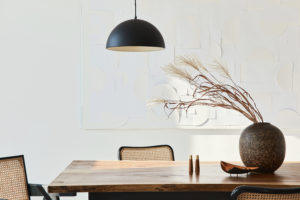Pro Tips for Painting Light Fixtures in 6 Easy Steps

If you have a light fixture that’s just right in every way but color, don’t ditch it — paint it. Painting light fixtures is a great way to get a custom look without the custom price tag.
Do You Have to Take Down a Light Fixture to Paint It?
You don’t have to take down a light fixture** to paint it, but taking it down may be easier in the long run. Here’s why:
- If you leave it attached**, you’ll be working on an unstable object that’s hanging from a ceiling while you stand on a ladder, which is a test of balance and patience, both.
- Rather than just prep the fixture, you’ll also have to prep the room to keep it safe from paint splatters.
- You need to handle the light gently while you work, taking care not to pull on the cord.
- If the fixture touches the ceiling, it can be tough to paint the fixture without also painting the ceiling.
But if you’re okay with those restrictions, the process of painting a light fixture is the same.
How to Paint a Light Fixture, Step by Step
- The first step is to turn off the power**. Whether you’re painting in situ or taking down the light, cut the power.
- Tape off the parts of the fixture you don’t want to paint, like the cord, decorative pieces, glass or switches.
- Lightly sand* the fixture with a fine-grit sandpaper.
- Clean the fixture with a tack cloth or rag, to ensure a clean, smooth surface.
- Apply your first coat of paint. We recommend spray painting light fixtures, not just because it’s easier than using a brush, but because you get a more even coat. Use a spray paint with built-in primer because it sticks to most surfaces. Once the paint dries, apply another coat or two, until you get the finish you’re happy with.
- Let your fixture dry for 24 hours and then rehang it.
Pro tip: If you’re painting glass light fixtures, look for paint made specifically for glass.
Painting Outdoor Light Fixtures
When painting outdoor light fixtures, it may be easier to leave them in place than take them down. If that’s the path you choose, you’ll have to protect the space around the light from paint splatters.
- Remove the decorative shield from the housing and take out any glass panels or globes. If the glass won’t separate from the shield, and you’re not painting the glass, then tape it off, leaving exposed only the metal pieces.
- Spray paint the decorative metal pieces.
- Unscrew the lightbulb and tape the socket**. Unscrew the fixture just enough to slide a sheet of newspaper or other protective paper behind it.
- If the day is windy enough to blow the paint, build a bottomless rectangle out of four pieces of leftover cardboard (or whatever you have around) and tape it to the paper, so that the sides of the rectangle create a box to catch any blowing paint.
- Spray paint the housing and canopy (where it attaches to the wall) inside and out. Give everything two to three coats, until you get the look you want.
- Remove the paper (and protective box if you used it) and reassemble the light. This is a good time to clean the glass and put in in a new bulb.
Want more great painting ideas? Check out our featured projects or browse our color tool, where you’ll find trending colors, plus contact info for our color consultants.
*WARNING! If you scrape, sand, or remove old paint, you may release lead dust. LEAD IS TOXIC. EXPOSURE TO LEAD DUST CAN CAUSE SERIOUS ILLNESS, SUCH AS BRAIN DAMAGE, ESPECIALLY IN CHILDREN. PREGNANT WOMEN SHOULD ALSO AVOID EXPOSURE. Wear a NIOSH-approved respirator to control lead exposure. Clean up carefully with a HEPA vacuum and a wet mop. Before you start, find out how to protect yourself and your family by contacting the National Lead Information Hotline at 1-800-424-LEAD or log on to www.epa.gov/lead.
**Check with an electrical expert.
